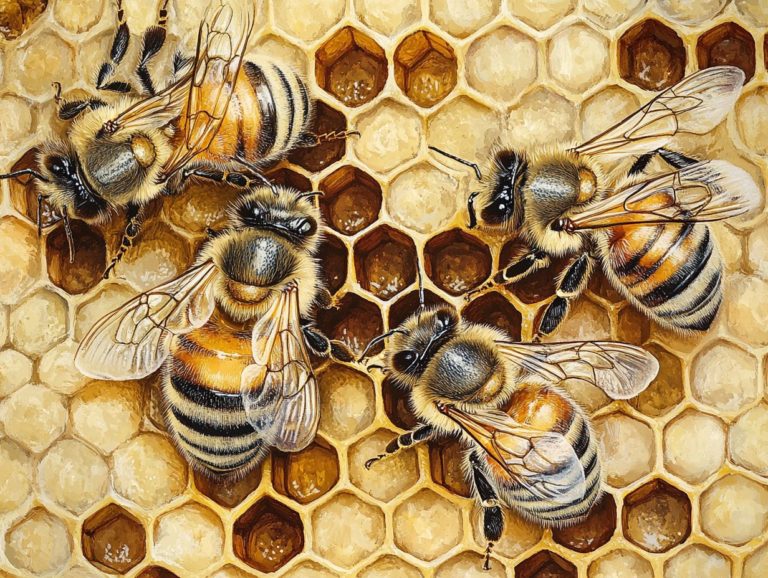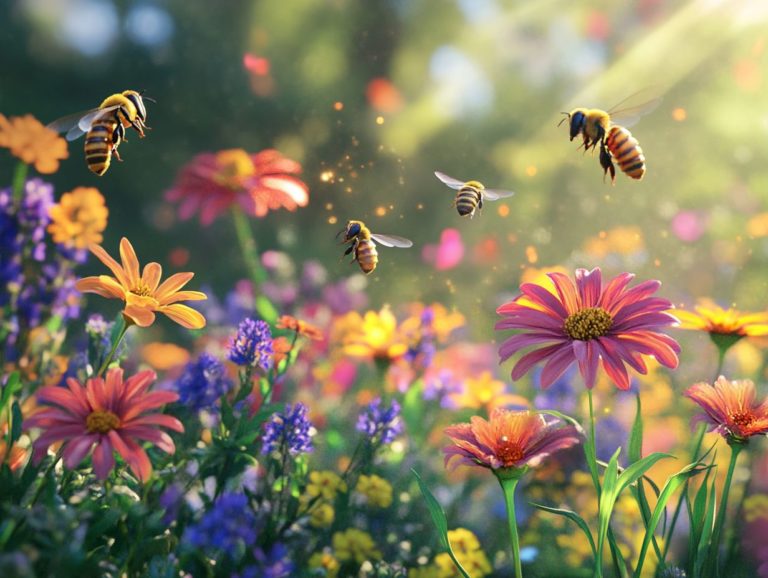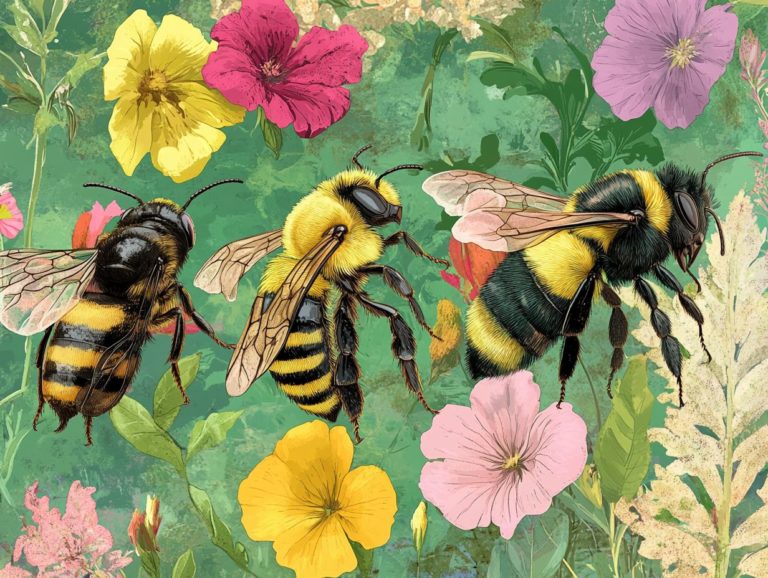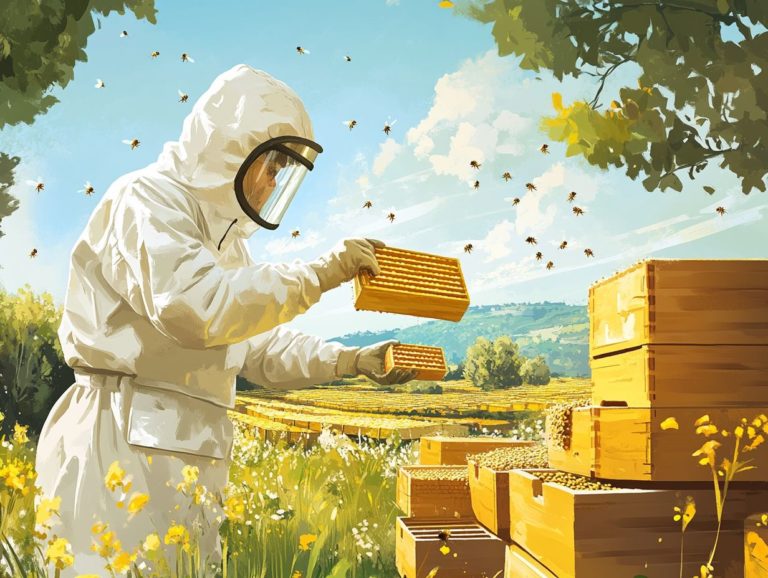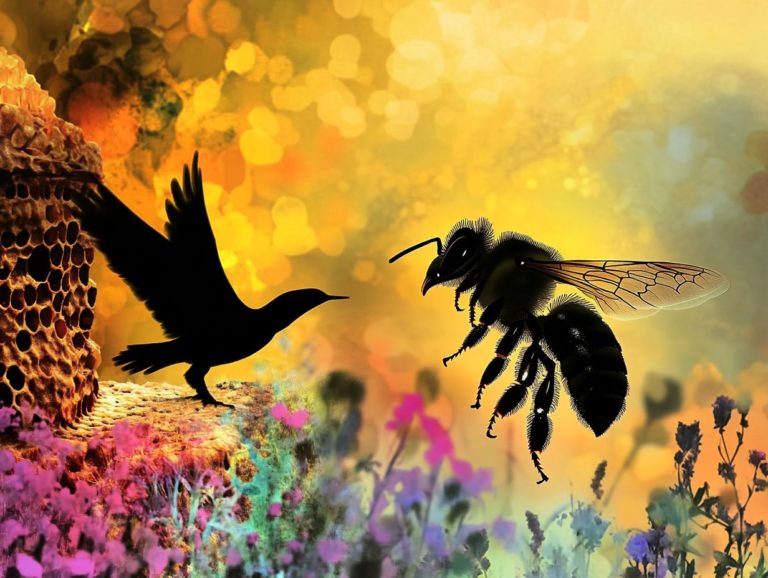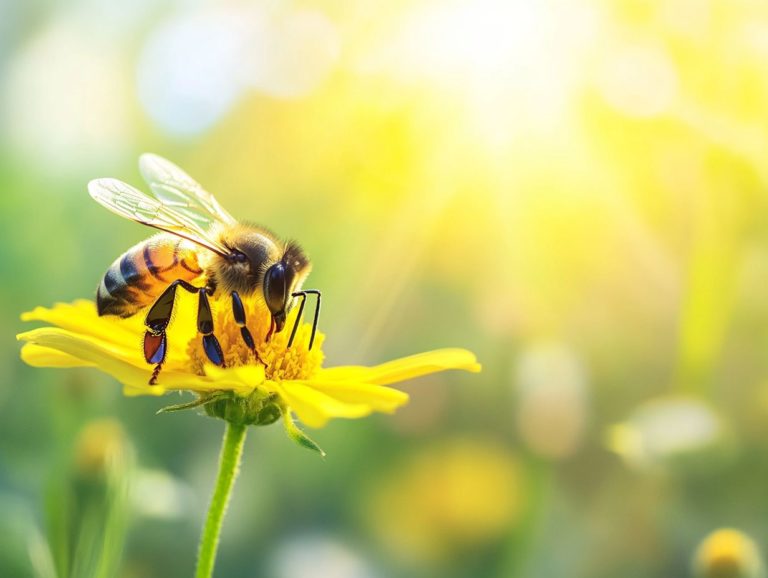What You Need to Know About Drone Bees
Drone bees are crucial to the hive’s ecosystem. Their role is often overlooked.
Let s dive into the world of drone bees and discover their fascinating characteristics and vital roles in the hive! You ll learn about their developmental stages and lifespan while examining their reproduction, feeding, and importance to beekeeping and agriculture, as well as understanding drone behavior and the impact of Varroa destructor.
Together, we will uncover the fascinating world of these essential pollinators.
Get ready to learn why drone bees are vital to the hive’s survival and how they impact our ecosystem!
Contents
- Key Takeaways:
- What Are Drone Bees?
- What Is the Role of Drone Bees in a Hive?
- What Is the Life Cycle of a Drone Bee?
- What Is the Purpose of Drone Bees in a Hive?
- Why Do Beekeepers Sometimes Cull Drone Bees?
- What Is the Impact of Drone Bees on the Bee Population?
- Are Drone Bees Necessary for a Hive to Survive?
- How Do Drone Bees Reproduce?
- What Is the Future of Drone Bees in Beekeeping and Agriculture?
- Frequently Asked Questions
- 1. What are drone bees and what is their role in the hive?
- 2. How can you distinguish drone bees from other honey bees and worker bees?
- 3. Are drone bees necessary for a healthy hive?
- 4. How do drone bees mate with the queen bee?
- 5. How long do drone bees live?
- 6. Can drone bees produce honey or contribute to brood development?
Key Takeaways:
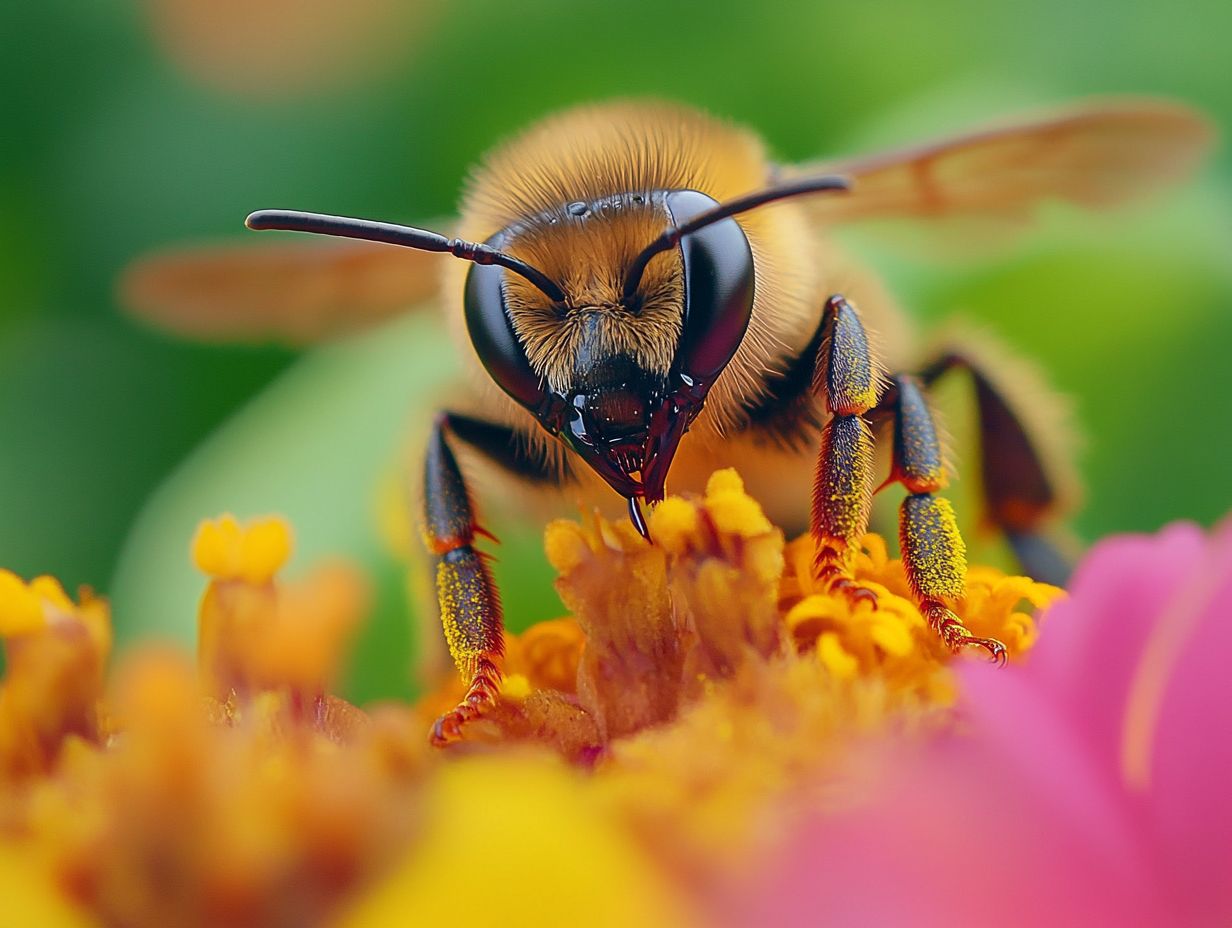
1. Drone bees are male bees that do not have stingers and do not collect pollen or nectar like worker bees. They play a crucial role in the reproduction of a hive, often involving drone congregation areas, and are raised during the spring and summer months.
2. The primary purpose of drone bees is to mate with virgin queen bees during mating flights. This ensures the survival and genetic diversity of the hive. They help keep the hive warm and maintain humidity levels.
3. Drone bees live for about 90 days on average and go through four stages of development: egg, larva, pupa, and adult. They are larger than worker bees and have larger eyes for better flying ability.
What Are Drone Bees?
Drone bees are the male members of a honey bee colony, and they play an essential role in the reproductive process. Unlike worker bees, which are female and handle various tasks within the hive like gathering pollen and temperature regulation drones have a singular focus: mating with the queen bee to ensure genetic diversity within the colony.
These haploid bees, which means they have only one set of chromosomes, are male and stand out due to their larger size and specialized mating behaviors. In the spring, you’ll witness drone congregations, where these male bees gather in anticipation of the queen’s mating flight an event that is vital for the colony’s survival and genetic lineage.
What Is the Role of Drone Bees in a Hive?
Drone bees are essential to the reproductive functions of a bee colony, affecting the colony’s health and survival. Their primary role is to mate with the queen during her mating flight, which takes place in designated drone congregation areas, often synchronized with the seasonal occurrence of spring.
This mating process is not just a mere formality; it enhances the genetic diversity within the hive, strengthening the entire colony. A healthy population of drones ensures that the queen has access to multiple mating partners, fostering a robust genetic foundation for future generations. Sometimes beekeepers use specific methods to help ensure that the queen mates with several drones.
How Do Drone Bees Differ from Worker Bees and Queen Bees?
Drone bees, worker bees, and queen bees each play distinct roles within the hive, reflecting their unique biological and functional differences. Drones, the male bees designed primarily for mating, stand out with their larger size and lack of stingers.
Worker bees are smaller females who take on a variety of responsibilities, from foraging and caring for the brood to maintaining the brood nest and hive itself.
At the heart of this intricate society is the queen bee, the sole reproductive female crucial for egg production and the genetic diversity of the colony. Each type of bee contributes to the hive’s overall functionality, ensuring the survival and efficiency of the entire bee colony. The queen’s pheromones, or chemicals used for communication among bees, play a vital role in maintaining colony cohesion.
To truly grasp the dynamics of bee society, you must explore the specific attributes and responsibilities of each type. Drones, focused on mating success, rely on the queen s pheromones to find her during swarming. They engage in impressive aerial displays to vie for her attention. Their genetic contribution is significant, but their lifespan is short, as they perish soon after mating and leave behind a mating sign or endophallus.
Worker bees have a longer lifespan and take on a multitude of tasks. They clean the brood frames, feed the larvae, and defend the hive. All of these tasks are vital for nurturing the colony s future generations. This organized structure is essential for the hive’s prosperity.
The queen, although solitary in her reproductive duties, ensures the hive operates smoothly by laying numerous eggs each day. Her prolific egg production sustains the population and fortifies the hive’s resilience, making her role essential to the colony’s success.
What Is the Life Cycle of a Drone Bee?
The life cycle of a drone bee unfolds in a captivating series of distinct stages, journeying from egg to adulthood. It starts with fertilized eggs laid in specially crafted drone brood cells within the brood nest.
In about three days, these eggs hatch into larvae, lovingly tended to by nurse bees until they transition into the pupa stage. This developmental phase is critical for helping raise healthy drones, as these male bees are destined to partake in mating flights.
The progression through these stages mirrors the timing and conditions of the hive, especially in spring, when the emergence of drones beautifully coincides with the queen’s mating period.
What Are the Stages of Development for a Drone Bee?
Understanding the stages of development for a drone bee is essential for grasping its role and significance within the colony.
This life cycle commences with the egg stage, where fertilized eggs are carefully placed in drone brood cells. It takes about three days to hatch. Inside the hive, the environment must maintain a cozy temperature of around 34-36 C to facilitate optimal larval growth.
Once hatched, the larvae are treated to a nutrient-rich diet, courtesy of the diligent nurse bees. Their nurturing is vital for their survival and development.
This nurturing phase persists for approximately six days, after which the larvae spin their cocoons and transition into the pupa stage, lasting about one week. During this critical period, maintaining temperature regulation is paramount, as the pupae require consistent warmth to metamorphose into adult bees.
Upon their emergence from the pupae, the drones are fully equipped to fulfill their essential role within the hive. Their emergence synchronizes with the queen’s mating flights, thereby bolstering the colony’s reproductive strategy.
Next time you see a bee, remember its incredible journey!
How Long Do Drone Bees Live?
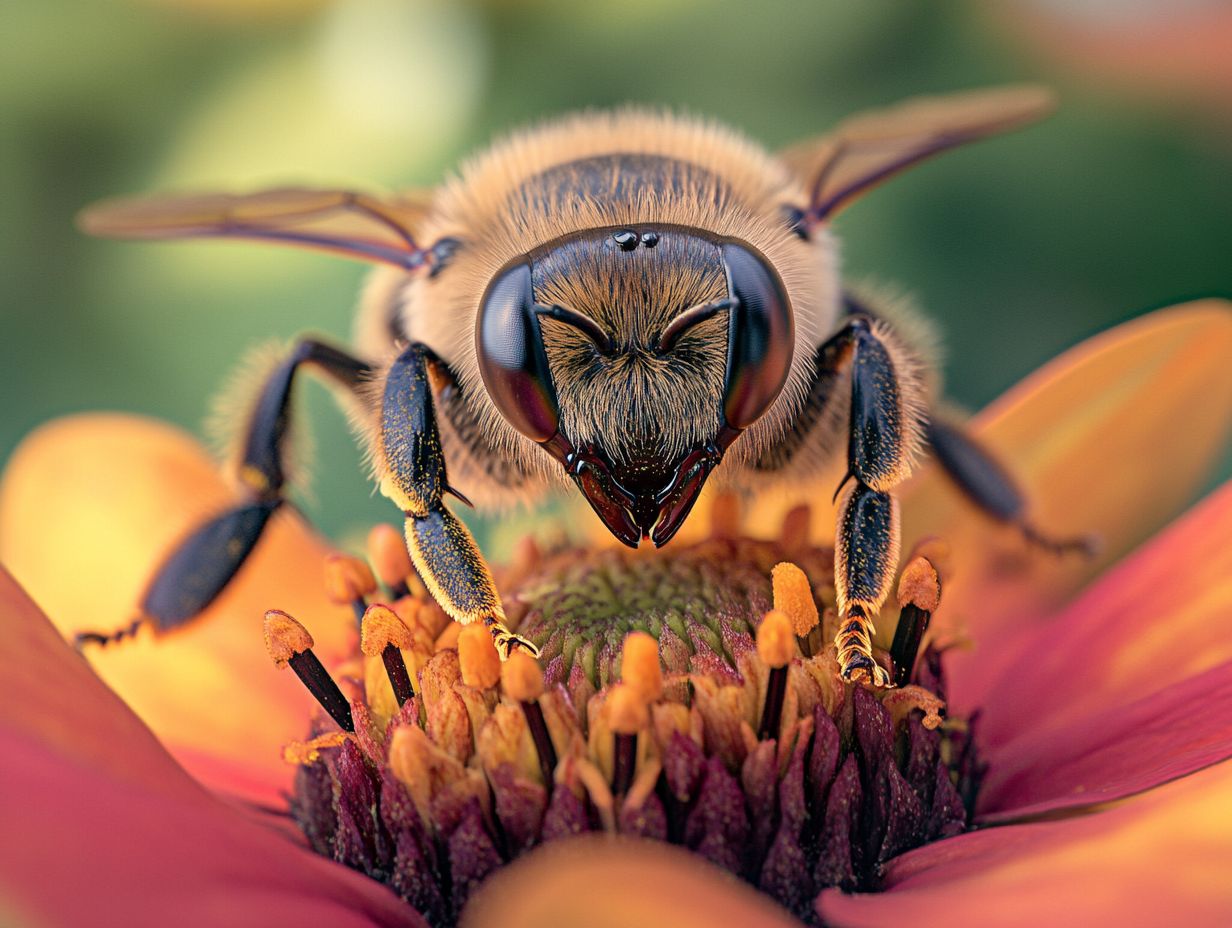
The lifespan of drone bees is relatively brief, typically spanning from a few weeks to a couple of months, influenced by a variety of environmental factors and the dynamics within the colony. You ll find that drones emerge in the spring, strategically timed to maximize their chances for mating success, which coincides with the queen’s mating flights.
This period is often marked by the building of drone comb, which refers to the specific cells built in the hive to rear drone bees, in preparation for brood development.
However, as autumn approaches and the hive prepares to conserve resources, many drones face the unfortunate fate of being ejected from the hive, leading to a struggle for survival. This drone ejection is part of the seasonal cycle that underscores the fascinating balance of life that keeps the bee colony thriving!
Several factors govern the lifespan of these drones, with seasonal changes holding particular significance. During the warmer months, an abundance of flowers and food bolsters the health and strength of the colony, enhancing the viability of the drones.
Yet, as colder weather looms, opportunities for mating begin to dwindle, directly affecting swarm preparation. The timing of environmental conditions temperature fluctuations and weather patterns further dictates the success of drone mating efforts, intricately shaping the reproductive strategy of the colony.
In essence, the interplay of these various elements not only impacts individual drones but also plays a key role in determining the overall success and resilience of the colony.
What Is the Purpose of Drone Bees in a Hive?
The primary role of drone bees in a hive revolves around reproduction and enriching the genetic diversity of the colony. As the male counterparts of the honey bee, drones are specifically designed to mate with the queen during her mating flight, ensuring that the genetic foundation of the colony remains strong and varied. This reproductive strategy is rooted in a system where males have one set of chromosomes and females have two.
This genetic infusion is vital for the overall strength and resilience of the bee population, facilitating the colony’s survival amidst fluctuating environmental conditions and potential threats. Maintaining a healthy population of drones is essential in the spring, a time when mating opportunities flourish. The seasonal occurrence of drone reproduction coincides with swarm preparation.
Do Drone Bees Collect Pollen or Nectar?
Unlike worker bees, drone bees don t collect pollen or nectar; their main focus is on reproduction rather than foraging. While worker bees diligently gather these essential resources to support the hive, drones engage in mating flights, playing a critical role in ensuring the colony s continuation. The absence of pollen gathering by drones emphasizes their specialized role in reproductive functions.
Their larger size and specialized biological functions prevent them from participating in the foraging tasks that worker bees manage so adeptly. This also means that drones rely on the brood frame resources gathered by worker bees for survival.
This dependence on worker bees for food collection is vital for the overall health and efficiency of the colony. If these dedicated foragers are absent or unable to gather sufficient pollen, the hive’s food stores dwindle, putting everyone workers, drones, and the queen alike at risk.
Such an imbalance can disrupt the delicate dynamics within the colony, potentially leading to resource shortages that can impact reproductive success. Maintaining a consistent flow of pollen and nectar is crucial; without a steady supply of these crucial resources, the entire bee community’s survival hangs in the balance!
Do Drone Bees Sting?
Drone bees stand out among their honey bee relatives due to their inability to sting. This quality sets them apart from both worker bees and queen bees. Worker bees use their stingers as a means of defense, while drones cannot sting at all. Their primary role within the hive is centered around mating and reproduction. This absence of a stinger highlights the non-aggressive nature of drones, allowing them to coexist peacefully within the colony.
With no threat of a sting, worker bees can engage with drones without fear. This unique characteristic fosters a spirit of collaboration that is essential for the hive s survival. Drones’ lack of defensive abilities underscores their specialized role; they focus solely on reproductive tasks, bolstering the genetic diversity of the colony. This dynamic contributes to the overall health and resilience of the hive, ensuring its success in an ever-evolving ecosystem.
Do Drone Bees Help in Hive Maintenance?
Drone bees don t actively assist with hive maintenance. That responsibility falls on the diligent worker bees. These industrious bees manage everything from brood development to collecting pollen and regulating temperature within the colony. While drones play a crucial role in reproduction, they do not contribute to the daily upkeep of the hive.
This clear division of roles illustrates the specialization within the bee community. Worker bees ensure the colony’s strength and survival, while drones focus solely on finding mating opportunities.
Worker bees epitomize versatility. They take on various tasks as they mature, nurturing young larvae before transitioning to foraging for nectar and pollen. Eventually, they defend their community.
This organized hierarchy cultivates a thriving environment where efficiency reigns supreme. The collective efforts of worker bees significantly enhance the overall health and productivity of the colony. In stark contrast, drones simply wait for the opportunity to mate. This further emphasizes the distinction between roles that maintain the hive and those dedicated to reproduction.
Why Do Beekeepers Sometimes Cull Drone Bees?
As a beekeeper, you may find it necessary to cull drone bees to safeguard the health and vitality of your hive, especially when facing threats like Varroa destructor, a harmful mite. Drones are larger and less productive than worker bees, consuming valuable resources without foraging or maintaining the hive.
By strategically managing the drone population, you can enhance the overall dynamics of the colony. This prioritizes the survival and efficiency of worker bees those essential agents responsible for collecting pollen and maintaining the hive. Be sure to monitor your hives for signs of overpopulation or health stress!
What Is the Impact of Drone Bees on the Bee Population?
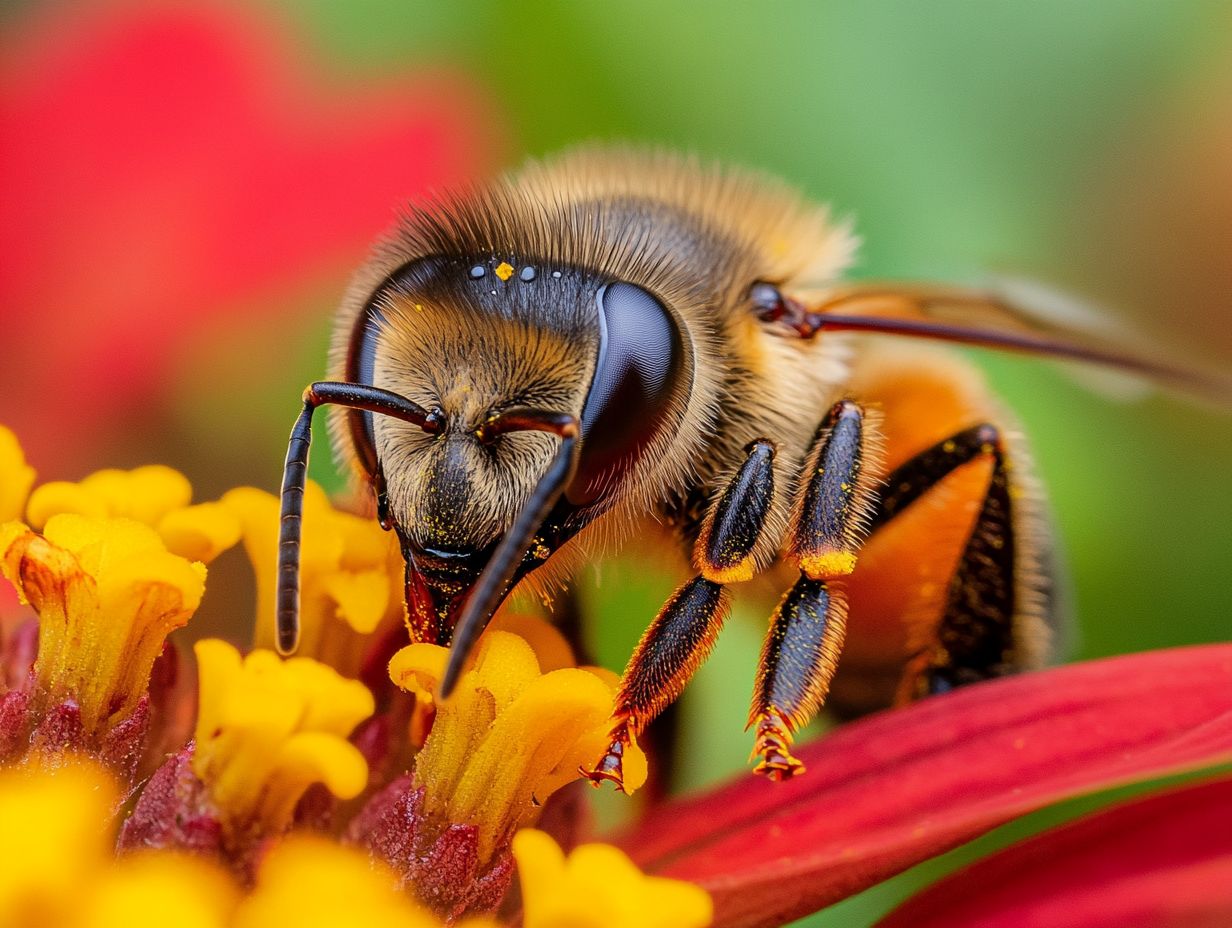
Drone bees play a vital role in shaping the bee population by enhancing genetic diversity. This diversity is crucial for the resilience and adaptability of colonies. When drones engage in mating flights with queen bees, they create a robust genetic foundation for the population. This, in turn, bolsters the overall health and vigor of the colony.
This genetic diversity acts as a buffer against diseases and environmental changes, strengthening the resilience of the bee population. Therefore, the presence and well-being of drone bees are essential for sustaining the stability and success of the bee community.
Are Drone Bees Necessary for a Hive to Survive?
Drone bees are essential for the survival of a hive due to their vital role in reproduction. Without drones, queen bees would be unable to mate, leading to a stagnation of genetic diversity within the hive.
This infusion of new genetic material is crucial not only for the health of the colony but also for its ability to adapt to changing environments and emerging threats. While drones may not engage in foraging or hive maintenance, their presence is fundamentally important for securing the future generations of bees within the colony.
How Do Drone Bees Reproduce?
Drone bees reproduce through a specialized mating process that unfolds during the queen’s mating flights. This event is crucial for ensuring the genetic diversity of the colony.
During these flights, several drones compete to mate with the queen, supplying her with genetic material from a variety of males. This enhances the overall genetic contribution to the hive and strengthens the colony’s resilience against diseases and environmental challenges.
In this intricate dance of nature, drone bees emerge as vital players in the hive’s success.
Are All Drone Bees Capable of Reproduction?
While all drone bees are designed for reproduction, not every one achieves mating success. This is largely due to factors like competition and genetic diversity within the hive.
Only the drones that mate with a queen during her mating flights contribute to the colony’s genetic lineage. This selective process ensures that only the fittest and most genetically favorable drones pass on their genes, which is essential for maintaining the health and adaptability of the bee population.
Environmental conditions are also important; factors such as temperature, availability of food sources, and habitat variation can significantly impact drone behavior and the timing of their mating flights. The level of competition among drones is significant those that show superior endurance and agility often excel in courtship.
Genetic selection plays a key role as well, ensuring that only those drones with optimal traits successfully mate. The interplay of these elements shapes the overall fitness of the colony and influences the genetic diversity of the population.
This process creates a strong and adaptable bee community, ready to face any challenges!
What Happens to Drone Bees After Mating?
After mating, drone bees undergo a remarkable transformation in their lifespan and role within the colony, often resulting in their removal from the hive. Once a drone successfully mates with a queen, it typically meets its end shortly after due to the physical demands of the mating process.
This removal after mating is a natural aspect of hive dynamics, allowing the colony to conserve resources for the worker bees and the queen.
While the mating process is essential for the colony’s reproduction, it profoundly impacts the drones’ existence, ensuring that only the fittest genes are carried forward.
This behavior serves several important functions beyond mere genetic propagation. By removing drones that have fulfilled their reproductive roles, the hive enhances its resource allocation, prioritizing the nurturing of worker bees who undertake essential tasks like foraging and hive maintenance.
The success of drone mating significantly influences the colony’s overall health, as it shapes the genetic diversity and resilience of future generations. Strong mating outcomes can lead to a more effective resource management strategy, as a well-mated queen is likely to produce a thriving brood, safeguarding the colony’s longevity and productivity.
What Is the Future of Drone Bees in Beekeeping and Agriculture?
The future of drone bees in beekeeping and agriculture is crucial for the future of our ecosystems as we recognize the significance of genetic diversity and colony health.
Given the persistent challenges presented by pests such as Varroa destructor (a harmful mite that affects honey bees) and the evolving landscape of agricultural practices, maintaining a stable drone population becomes essential. This stability is critical for the resilience and adaptability of honey bee colonies.
As a beekeeper, you are now more attuned to the importance of managing drone populations, enhancing genetic diversity, and supporting reproductive success. These efforts not only bolster the health of your colonies but also contribute to sustainable agricultural practices that depend on effective pollination.
Frequently Asked Questions
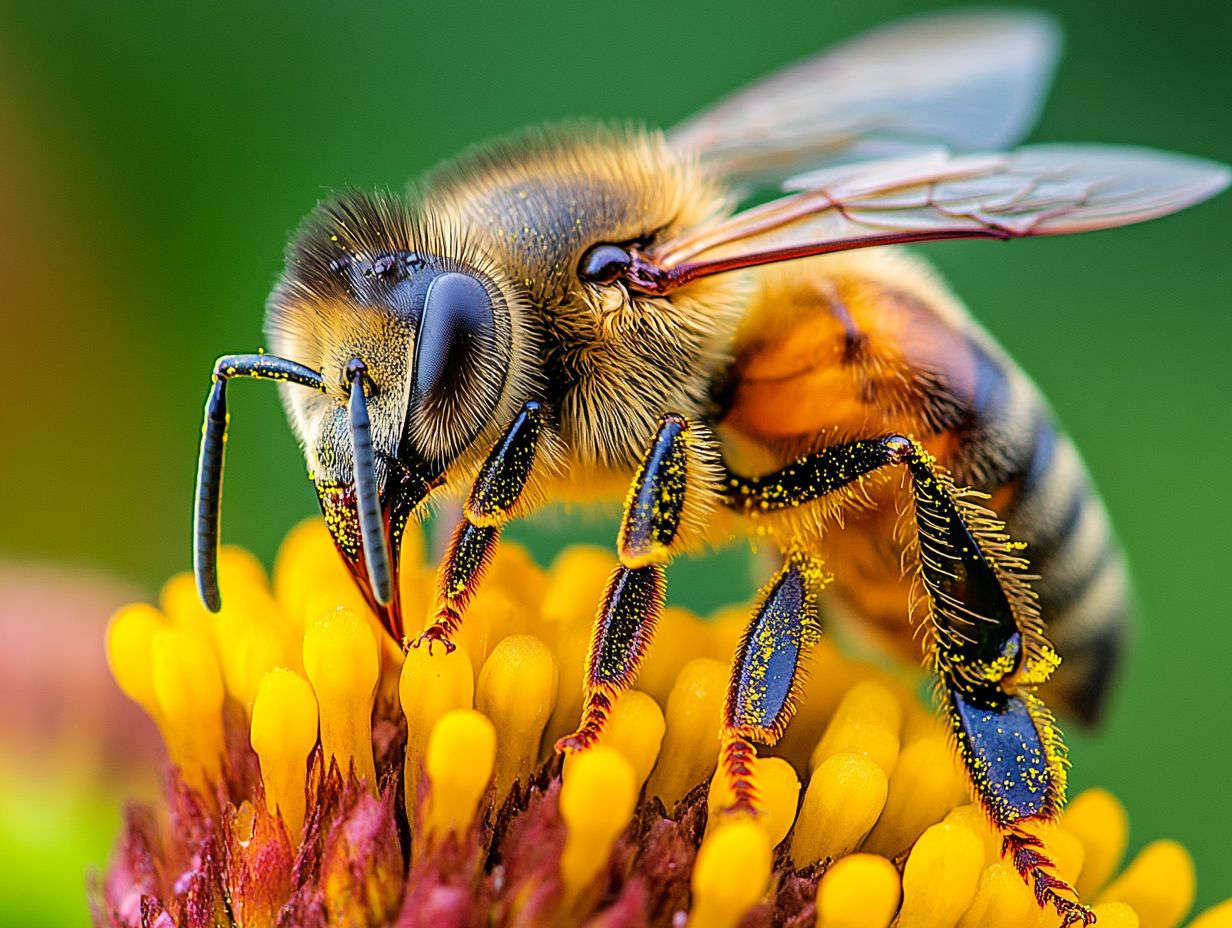
1. What are drone bees and what is their role in the hive?
Drone bees play a vital role in the hive’s future! They are male honey bees whose primary function is to mate with the queen bee during mating flights. They do not gather nectar or pollen, and their main role is to ensure the survival of the hive’s genetics and contribute to the genetic diversity of the bee colony.
2. How can you distinguish drone bees from other honey bees and worker bees?
Drone bees are larger in size compared to worker bees and have a more rounded abdomen. They also have bigger eyes and lack stingers, as their purpose is not to defend the hive. These drone characteristics make them easily distinguishable from other bees.
3. Are drone bees necessary for a healthy hive?
Drone bees don t contribute to daily hive operations like pollen gathering or temperature control. They are essential for the genetic diversity and health of the colony. Without drone bees, our buzzing friends wouldn t flourish! The queen bee would not be able to mate and produce future generations of bees. This genetic system involves both male and female bees, relying on haploid drone sperm to fertilize the queen’s diploid eggs during the mating process.
4. How do drone bees mate with the queen bee?
Drone bees will fly out of the hive to drone congregation areas and mate with the queen bee from other colonies in mid-air. Mating leaves the drone bee’s endophallus inside the queen as a mating sign, and the drone bee dies. The queen bee then returns to the hive to lay fertilized eggs and continue egg production.
5. How long do drone bees live?
Drone bees typically live around 90 days. In winter, they are often ejected from the hive to conserve resources. This seasonal occurrence helps maintain colony strength through the colder months.
6. Can drone bees produce honey or contribute to brood development?
No, drone bees cannot collect or store nectar to make honey. They rely on worker bees to feed them and support their needs in the hive. This feeding behavior is crucial for their survival as they perform their reproductive functions.

